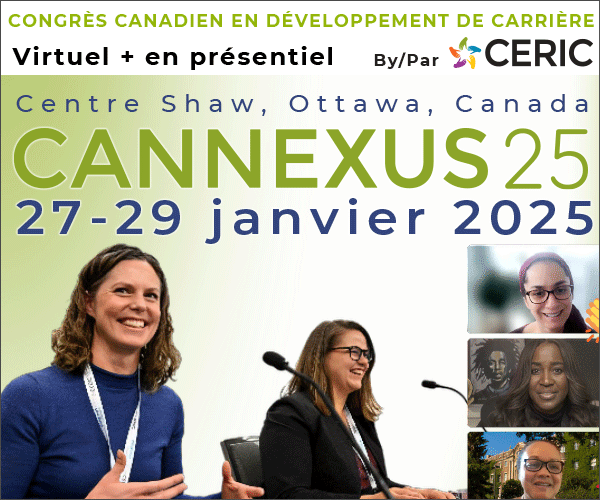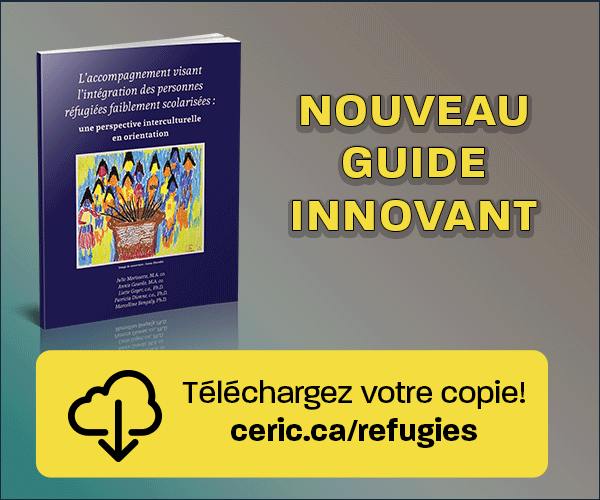L'image de marque de l'employeur : A travers la lentille de la croissance professionnelle et de l'attractivité de l'organisation
DOI :
https://doi.org/10.53379/cjcd.2024.395Mots-clés :
Possibilités d'évolution de carrière, Image de marque de l'employeur, Attractivité de l'organisation Théorie de la signalisation, Théorie de l'identité sociale, Le bouche à oreille, Utilisation des médias sociauxRésumé
Cette étude explore le rôle clé que joue l'image de marque de l'employeur dans l'évolution de la carrière individuelle et l'attrait d'une organisation en général, en particulier dans le secteur des technologies de l'information. Une analyse approfondie de la littérature, qui fonde l'étude sur des théories bien établies en matière de marque d'employeur, complète les données qualitatives fournies par des entretiens approfondis avec des responsables des ressources humaines. L'étude utilise le SORA (Summary Oral Reflective Analytics) pour découvrir des points de vue complexes. Elle révèle l'interdépendance des médias sociaux et du bouche-à-oreille, en soulignant leur impact combiné sur les possibilités de croissance de carrière et l'attractivité de l'organisation. Les implications managériales découlant de ces résultats fournissent aux entreprises des tactiques pratiques qui mettent l'accent sur l'intégration stratégique des médias sociaux et du bouche-à-oreille afin de maximiser les initiatives de promotion de la marque employeur. En outre, cette étude reconnaît le rôle vital que ces aspects interconnectés jouent dans la détermination de la réussite dans le paysage concurrentiel des technologies de l'information et fournit des idées pratiques pour orienter les pratiques organisationnelles.
Références
Ahamad, F. (2019). Impact of word-of-mouth, job attributes and relationship strength on employer attractiveness. Management Research Review, 42(6), 721–739. https://doi.org/10.1108/MRR-11-2017-0382
Ahamad, F., Saini, G. K., & Jawahar, I. M. (2022). Interactive influence of work–life balance benefits, employee recommendation, and job attributes on employer attractiveness and job pursuit intentions: two experiments. Asian Business & Management, (0123456789). https://doi.org/10.1057/s41291-022-00184-4
Alonso, J. M., Parsons, E., & Pirani, D. (2022). Career-washing? Unpacking employer brand promises on social media platforms. European Journal of Marketing, 56(10), 2804–2825. https://doi.org/10.1108/EJM-10-2021-0817
Ambler, T., & Barrow, S. (1996). The employer brand. Journal of Brand Management, 4(3), 185–206. https://doi.org/10.1057/bm.1996.42
Arasanmi, C. N., & Krishna, A. (2019). Employer branding: perceived organisational support and employee retention – the mediating role of organisational commitment. Industrial and Commercial Training, 51(3), 174–183. https://doi.org/10.1108/ICT-10-2018-0086
Backhaus, K. B., Stone, B. A., & Heiner, K. (2002). Exploring the Relationship Between Corporate Social Performance and Employer Attractiveness. Business & Society, 41(3), 292–318. https://doi.org/10.1177/0007650302041003003
Backhaus, K., & Tikoo, S. (2004). Conceptualizing and researching employer branding. Career Development International, 9(5), 501–517. https://doi.org/10.1108/13620430410550754
Biswakarma, G. (2016). Organizational Career Growth and Employees" Turnover Intentions: An empirical evidence from Nepalese Private Commercial Banks. International Academic Journal of Organizational Behavior and Human Resource Management International Academic Journal of Organizational Behavior and Human Resource Management, 3(2), 10–26. http://www.iaiest.com
Biswas, M. K., & Suar, D. (2016). Antecedents and Consequences of Employer Branding. Journal of Business Ethics, 136(1), 57–72. https://doi.org/10.1007/s10551-014-2502-3
Carlini, J., Grace, D., France, C., & Lo Iacono, J. (2019a). The corporate social responsibility (CSR) employer brand process: integrative review and comprehensive model. Journal of Marketing Management, 35(1–2), 182–205. https://doi.org/10.1080/0267257X.2019.1569549
Carlini, J., Grace, D., France, C., & Lo Iacono, J. (2019b). The corporate social responsibility (CSR) employer brand process: integrative review and comprehensive model. Journal of Marketing Management, 35(1–2), 182–205. https://doi.org/10.1080/0267257X.2019.1569549
Carpentier, M., Hoye, G. Van, & Weng, Q. (2019). Social Media Recruitment: Comunication Characteristics and Sought Gratifications. Frontiers in Psycology, 10, 1–12. https://doi.org/10.3389/fpsyg.2019.01669
Carpentier, M., Van Hoye, G., & Weijters, B. (2019). Attracting applicants through the organization’s social media page: Signaling employer brand personality. Journal of Vocational Behavior, 115(September 2018), 103326. https://doi.org/10.1016/j.jvb.2019.103326
Cascio, W. F., & Graham, B. Z. (2016). New Strategic Role for HR : Leading the Employer-Branding Process. Organization Management Journal, 13(4), 182–192.
Celani, A., & Singh, P. (2011). Signaling theory and applicant attraction outcomes. Personnel Review, 40(2), 222–238. https://doi.org/10.1108/00483481111106093
Charbonnier-Voirin, A., Poujol, J. F., & Vignolles, A. (2017). From value congruence to employer brand: Impact on organizational identification and word of mouth. Canadian Journal of Administrative Sciences, 34(4), 429–437. https://doi.org/10.1002/cjas.1379
Chawla, P. (2019). Impact of employer branding on employee engagement in business process outsourcing (BPO) sector in India: mediating effect of person–organization fit. Industrial and Commercial Training, 15(1), 35–49. https://doi.org/10.1108/ICT-06-2019-0063
Chhabra, N. L., & Sharma, S. (2014a). Employer branding: Strategy for improving employer attractiveness. International Journal of Organizational Analysis, 22(1), 48–60. https://doi.org/10.1108/IJOA-09-2011-0513
Chhabra, N. L., & Sharma, S. (2014b). Employer branding: Strategy for improving employer attractiveness. International Journal of Organizational Analysis, 22(1), 48–60. https://doi.org/10.1108/IJOA-09-2011-0513
Chiang, L. L., Xu, A., Kim, J., Tang, L. R., & Manthiou, A. (2017). Investigating festivals and events as social gatherings : the application of social identity theory. Journal of Travel & Tourism Marketing, 34(6), 779–792. https://doi.org/10.1080/10548408.2016.1233927
Colbert, A. E., Bono, J. E., & Purvanova, R. K. (2016). Flourishing Via Workplace Relationships: Moving Beyond Instrumental Support. Accademy of Management Journal, 59(4), 1199–1223.
Connelly, B. L., Certo, S. T., Ireland, R. D., & Reutzel, C. R. (2011). Signaling theory: A review and assessment. Journal of Management, 37(1), 39–67. https://doi.org/10.1177/0149206310388419
Cullen-lester, K. L., Maupin, C. K., & Carter, D. R. (2017). Incorporating social networks into leadership development : A conceptual model and evaluation of research and practice. The Leadership Quarterly, 28(1), 130–152. https://doi.org/10.1016/j.leaqua.2016.10.005
Dabirian, A., Berthon, P., & Kietzmann, J. (2019). Enticing the IT crowd: EB in the Informationa Economy. Journal of Business & Industrial Marketting, 7(April), 1403–1409. https://doi.org/10.1108/JBIM-11-2018-0333
Dabirian, A., Kietzmann, J., & Paschen, J. (2018). Employer Branding : Understanding Employer Attractiveness of IT Companies. IEEE Computer Society, 82–89.
Davidescu, A. A., Apostu, S.-A., Paul, A., & Casuneanu, I. (2020). Work Flexibility , Job Satisfaction , and Job Performance among Romanian Employees — Implications for Sustainable Human Resource Management. Sustainability, 1–53. https://doi.org/10.3390/su12156086
Deepa, R., & Baral, R. (2020). Relationship between integrated communication effectiveness and employee-based brand equity – mediating role of psychological contract fulfillment. Journal of Product and Brand Management, 30(6), 883–897. https://doi.org/10.1108/JPBM-01-2019-2212
Deepa, R., & Baral, R. (2022). Is my employee still attracted to me? Understanding the impact of integrated communication and choice of communication channels on employee attraction. Corporate Communications, 27(1), 110–126. https://doi.org/10.1108/CCIJ-09-2020-0136
Durocher, S., Bujaki, M., & Brouard, F. (2016). Attracting Millennials : Legitimacy management and bottom-up socialization processes within accounting firms. Critical Perspectives on Accounting, 39, 1–24. https://doi.org/10.1016/j.cpa.2016.02.002
Dutot, V. (2020). A social identity perspective of social media’s impact on satisfaction with life. Psychology and Marketing, 1–14. https://doi.org/10.1002/mar.21333
Eger, L., Mičík, M., Gangur, M., & Řehoř, P. (2019). Employer branding: Exploring attractiveness dimensions in a multicultural context. Technological and Economic Development of Economy, 25(3), 519–541. https://doi.org/10.3846/tede.2019.9387
Ewing, M., Men, L. R., & Neil, J. O. (2019). Using Social Media to Engage Employees : Insights from Internal Communication Managers. International Journal of Strategic Communication, 13(2), 110–132. https://doi.org/10.1080/1553118X.2019.1575830
Ewing, M., Men, L. R., & O’Neil, J. (2019). Using Social Media to Engage Employees: Insights from Internal Communication Managers. International Journal of Strategic Communication, 13(2), 110–132. https://doi.org/10.1080/1553118X.2019.1575830
Ewing, M. T., Pitt, L. F., Bussy, N. M. de, & Berthon, P. (2002). Employment branding in the knowledge economy. International Journal of Advertising, 21(1), 3–22.
Fujita, M., Harrigan, P., & Soutar, G. N. (2018). Capturing and Co-Creating Student Experiences in Social Media: a Social Identity Theory Perspective. Journal of Marketing Theory and Practice, 26(1–2), 55–71. https://doi.org/10.1080/10696679.2017.1389245
Gonzales, A. (2016). The contemporary US digital divide: from initial access to technology maintenance. Information Communication and Society, 19(2), 234–248. https://doi.org/10.1080/1369118X.2015.1050438
Guillot-Soulez, C., Saint-Onge, S., & Soulez, S. (2019). Linking employer labels in recruitment advertising, governance mode and organizational attractiveness. Recherche et Applications En Marketing, 34(3), 5–26. https://doi.org/10.1177/2051570719843066
Haddock-Millar, J., Sanyal, C., & Müller-Camen, M. (2016). Green human resource management: A comparative qualitative case study of a United States multinational corporation. International Journal of Human Resource Management, 27(2), 192–211. https://doi.org/10.1080/09585192.2015.1052087
Hanaysha, J. (2016). Testing the Effects of Employee Engagement , Work Environment , and Organizational Learning on Organizational Commitment. Procedia - Social and Behavioral Sciences, 229, 289–297. https://doi.org/10.1016/j.sbspro.2016.07.139
Harvey, W. S., Beaverstock, J. V., & Li, H. (2019). Common Threats and Managing Reputation in Executive Search Firms. British Journal of Management, 30(4), 847–868. https://doi.org/10.1111/1467-8551.12312
Helal, G., Ozuem, W., & Lancaster, G. (2018). Social media brand perceptions of millennials. International Journal of Retail and Distribution Management, 46(10), 977–998. https://doi.org/10.1108/IJRDM-03-2018-0066
Hong, P. C., Singh, N. P., Elangovan, N., & Yeon, G. (2022). Responding to pandemic challenges: leadership lessons from multinational enterprises (MNEs) in India. Journal of Management Development, 41(4), 205–222. https://doi.org/10.1108/JMD-11-2021-0309
Hoye, G. Van. (2012). Recruitment sources and organizational attraction_ A field study of Belgian nurses. European Journal of Work and Organizational Psychology, 21(3), 376–391.
Hoye, G. Van, & Lievens, F. (2005). Recruitment-Related Information Sources and Organizational Attractiveness : Can Something Be Done About Negative Publicity ? International Journal of Selection and Assessment, 13(3), 179–187.
Hoye, G. Van, & Lievens, F. (2007). Social influences on organizational attractiveness: Investigating if and when word of mouth matters. Journal of Applied Social Psychology, 37(9), 2024–2047. https://doi.org/10.1111/j.1559-1816.2007.00249.x
Hoye, G. Van, Weijters, B., Lievens, F., & Stockman, S. (2016). Social Influences in Recruitment : When is word-of-mouth most effective ? International Journal of Selection and Assessment, 24(1), 44–53.
Jahnke, J. R., Waldrop, J., Ledford, A., & Martinez, B. (2021). Uncovering Burdens , Examining Needs , and Shedding Assumptions of Evidence- Based Social Support Programs for Mothers : A Descriptive Qualitative Study in a Remote Community. Global Qualitative Nursing Research, 8, 1–13. https://doi.org/10.1177/23333936211035747
Jalilvand, M. R., Salimipour, S., Elyasi, M., & Mohammadi, M. (2017). Factors influencing word of mouth behaviour in the restaurant industry. Marketing Intelligence and Planning, 35(1), 81–110. https://doi.org/10.1108/MIP-02-2016-0024
Kargas, A., & Tsokos, A. (2020). Employer Branding Implementation and Human Resource Management in Greek Telecommunication Industry. Administrative Sciences, 10(1), 1–14. https://doi.org/10.3390/admsci10010017
Karjaluoto, H., Munnukka, F., & Kiuru, K. (2016). Brand love and positive word of mouth: the moderating effects of experience and price. Journal of Product and Brand Management, 25(6), 527–537. https://doi.org/10.1108/JPBM-03-2015-0834
Kashive, N., & Khanna, V. T. (2017a). Study of Early Recruitment Activities and Employer Brand Knowledge and Its Effect on Organization Attractiveness and Firm Performance. Global Business Review, 18(3S), S172–S190. https://doi.org/10.1177/0972150917693334
Kashive, N., & Khanna, V. T. (2017b). Study of Early Recruitment Activities and Employer Brand Knowledge and Its Effect on Organization Attractiveness and Firm Performance. Global Business Review, 18(3(S)), S172–S190. https://doi.org/10.1177/0972150917693334
Kashive, N., Khanna, V. T., & Bharthi, M. N. (2020). Employer branding through crowdsourcing: understanding the sentiments of employees. Journal of Indian Business Research, 12(1), 93–111. https://doi.org/10.1108/JIBR-09-2019-0276
Kaur, P., Sharma, S., Kaur, J., & Sharma, S. K. (2015). Using Social Media for Employer Branding and Talent Management: An Experiential Study. IUP Journal of Brand Management, 12(2), 7.
Keppeler, F., & Papenfuß, U. (2021). Employer Branding and Recruitment: Social Media Field Experiments Targeting Future Public Employees. Public Administration Review, 81(4), 763–775. https://doi.org/10.1111/puar.13324
Keyzer, F. De, Dens, N., & Pelsmacker, P. De. (2019). The Impact of Relational Characteristics on Consumer Responses to Word of Mouth on Social Networking Sites. International Journal of Electronic Commerce, 23(2), 212–243. https://doi.org/10.1080/10864415.2018.1564551
Kim, S., Mori, I., & Rahim, A. R. A. (2018). Cultural values matter: Attractiveness of Japanese companies in Malaysia. International Journal of Cross Cultural Management, 18(1), 87–103. https://doi.org/10.1177/1470595818759570
Kossek, E. E., Su, R., & Wu, L. (2017). “ Opting Out ” or “ Pushed Out ”? Integrating Perspectives on Women ’ s Career Equality for Gender Inclusion and Interventions. Journal of Management, 43(1), 228–254. https://doi.org/10.1177/0149206316671582
Kowalkowski, C., Gebauer, H., & Oliva, R. (2017). Service growth in product firms: Past, present, and future. Industrial Marketing Management, 60, 82–88. https://doi.org/10.1016/j.indmarman.2016.10.015
Kreiss, D., & Mcgregor, S. C. (2018). Technology Firms Shape Political Communication : The Work of Microsoft , Facebook , Twitter , and Google With Campaigns During the 2016 U . S . Presidential Cycle. Political Communication, 35(2), 155–177. https://doi.org/10.1080/10584609.2017.1364814
Kucherov, D., & Zhiltsova, E. (2021). Social Media in Employer Branding in FMCG in Russia : Millennials ’ Perspective. Journal of East-West Business, 27(2), 160–183. https://doi.org/10.1080/10669868.2020.1862383
Kumar, M., Jauhari, H., Rastogi, A., & Sivakumar, S. (2018). Managerial support for development and turnover intention. Journal of Organizational Change Managemen, 31(1), 135–153. https://doi.org/10.1108/JOCM-06-2017-0232
Kumari, S., & Saini, G. K. (2018). Do instrumental and symbolic factors interact in influencing employer attractiveness and job pursuit intention? Career Development International, 23(4), 444–462. https://doi.org/10.1108/CDI-03-2018-0069
Li, P., Yang, X., Yang, L. X., Xiong, Q., Wu, Y., & Tang, Y. Y. (2018). The modeling and analysis of the word-of-mouth marketing. Physica A: Statistical Mechanics and Its Applications, 493, 1–16. https://doi.org/10.1016/j.physa.2017.10.050
Lin, H.-F. (2015). The impact of company-dependent and company-independent information sources on organizational attractiveness perceptions. Journal of Management Development, 34(8), 941–959. https://doi.org/10.1108/JMD-12-2013-0161
Liu, Y. L., Keeling, K. A., & Papamichail, K. N. (2016). An exploratory study of jobseekers’ decision-making styles, recruitment information sources and organisational attractiveness. Personnel Review, 45(6), 1403–1427. https://doi.org/10.1108/PR-11-2014-0250
Ma, R., Cherian, J., Tsai, W.-H., Sial, M. S., Hou, L., & Álvarez-Otero, S. (2021). The Relationship of Corporate Social Responsibility on Digital Platforms , Electronic Word-of-Mouth , and Consumer-Company Identification : An Application of Social Identity Theory. Sustainability, 1–17.
Mabkhot, M. M., Al-Ahmari, A. M., Salah, B., & Alkhalefah, H. (2018). Requirements of the Smart Factory System : A Survey and Perspective. Machines, 1–22. https://doi.org/10.3390/machines6020023
Maheshwari, V., Gunesh, P., Lodorfos, G., & Konstantopoulou, A. (2017). Exploring HR practitioners’ perspective on employer branding and its role in organisational attractiveness and talent management. International Journal of Organizational Analysis, 25(5), 742–761. https://doi.org/10.1108/IJOA-03-2017-1136
Maurya, K. K., & Agarwal, M. (2018a). Organisational talent management and perceived employer branding. International Journal of Organizational Analysis, 26(2), 312–330. https://doi.org/10.1108/IJOA-04-2017-1147
Maurya, K. K., & Agarwal, M. (2018b). Organisational talent management and perceived employer branding. International Journal of Organizational Analysis, 26(2), 312–330. https://doi.org/10.1108/IJOA-04-2017-1147
McNab, S. M., & Johnston, L. (2002). The impact of equal employment opportunity statements in job advertisements on applicants ’ perceptions of organisations. Australian Journal of Psychology, 54(2), 105-109. https://doi.org/10.1080/00049530210001706573
Mehrad, D., & Mohammadi, S. (2017). Word of Mouth impact on the adoption of mobile banking in Iran. Telematics and Informatics, 34(7), 1351–1363. https://doi.org/10.1016/j.tele.2016.08.009
Mir, M. M., Amin, H., Omar, M., & Khan, S. (2022). Applicant Attraction towards the Organizational with the Moderation Effect of Gender: A Perception of Business Students. South Asian Journal of Management Sciences, 16(1), 59–75. http://dx.doi.org/10.21621/sajms.2022161.04
Monteiro, B., Santos, V., Reis, I., Sampaio, M. C., Sousa, B., Martinho, F., … Au-Yong-Oliveira, M. (2020). Employer Branding Applied to SMEs: A Pioneering Model Proposal for Attracting and Retaining Talent. Information, 11, 1–19. https://doi.org/10.3390/info11120574
Nawaz, M. S., & Pangil, F. (2016). Management Science Letters. Management Science Letters, 6, 157–176. https://doi.org/10.5267/j.msl.2015.12.006
Obeidat, A. M. (2019). The Relationship Between Perceived Human Resource Management Practices and Turnover-Intention: The Mediating Role of Organizational Attractiveness. Modern Applied Science, 13(2), 216–227. https://doi.org/10.5539/mas.v13n2p216
Oh, J., & Myeong, S. (2021). What matters for job security? Exploring the relationships among symbolic, instrumental images, and attractiveness for corporations in South Korea. Sustainability, 13(9), 1–14. https://doi.org/10.3390/su13094854
Oraedu, C., Izogo, E. E., Nnabuko, J., & Ogba, I.-E. (2020). Understanding electronic and face-to-face word-of-mouth influencers : an emerging market perspective. Management Research Review, 44(1), 112–132. https://doi.org/10.1108/MRR-02-2020-0066
Piric, V., Masmontet, P., & Martinovic, M. (2018). The Relationship between Employer Branding and Social Networks: Analysis from the Perspective of Young Graduates. Journal of Marketing Development and Competitiveness, 12(2), 30–48.
Potgieter, A., & Drive, M. (2018). Employer Branding as a Strategic Corporate Tool. African Journal of Business and Economic Research (AJBER), 13(1), 135–155. https://hdl.handle.net/10520/EJC-eefdea007
Prakash, C., Yadav, R., Singh, A., & Aarti. (2022). An Empirical Investigation of the Higher Educational Institutions’ Attractiveness as an Employer. South Asian Journal of Human Resources Management, 9(1), 130–148. https://doi.org/10.1177/23220937221078118
Price, S., & Reichert, C. (2017). The Importance of Continuing Professional Development to Career Satisfaction and Patient Care : Meeting the Needs of Novice to Mid- to Late-Career Nurses throughout Their Career Span. Administrative Sciences, 41–52. https://doi.org/10.3390/admsci7020017
Reis, G. G., Braga, B. M., & Trullen, J. (2017). Workplace authenticity as an attribute of employer attractiveness. Personnel Review, 46(8), 1962–1976. https://doi.org/10.1108/PR-07-2016-0156
Ring, A., Tkaczynski, A., & Dolnicar, S. (2016). Word-of-Mouth Segments: Online, Offline, Visual or Verbal? Journal of Travel Research, 55(4), 481–492. https://doi.org/10.1177/0047287514563165
Saini, G. K., & Jawahar, I. M. (2019). The influence of employer rankings , employment experience , and employee characteristics on employer branding as an employer of choice. Career Development International, 24(7), 636–657. https://doi.org/10.1108/CDI-11-2018-0290
Saini, G. K., Rai, P., & Chaudhary, M. K. (2014). What do best employer surveys reveal about employer branding and intention to apply? Journal of Brand Management, 21(2), 95–111. https://doi.org/10.1057/bm.2013.10
Schmalz, D. L., Colistra, C. M., & Evans, K. E. (2015). Social Media Sites as a Means of Coping with a Threatened Social Identity. Leisure Sciences, 37(1), 20–38. https://doi.org/10.1080/01490400.2014.935835
Spencer, M. (1973). Job Market Signaling. The Quarterly Journal OfEconomics, 87(3), 355–374. https://doi.org/10.1055/s-2004-820924
Srivastava, A., Tripathi, V., & Rajlaxmi. (2021). Can Employer Branding Hold? Case of Indian IT Industry During Covid-19. IUP Journal of Brand Management, 18(2), 7–23. https://www.proquest.com/openview/1683d019afd49ca2b14615a89dc2962d/1.pdf?pq-origsite=gscholar&cbl=2029986
Tanwar, K., & Prasad, A. (2016). Exploring the Relationship between Employer Branding and Employee Retention. Global Business Review, 17(3S), 186S-206S. https://doi.org/10.1177/0972150916631214
Thompson, S. M., & Barrett, P. A. (1997). Summary Oral Reflective Analysis: A Method for Interview Data Analysis in Feminist Qualitative Research. Advances in Nursing Science, 20, 55–65. https://doi.org/10.1097/00012272-199712000-00007
Trust, T., Carpenter, J. P., & Krutka, D. G. (2018). Leading by learning : exploring the professional learning networks of instructional leaders. Educational Media International, 55(2), 137–152. https://doi.org/10.1080/09523987.2018.1484041
Uen, J. F., Ahlstrom, D., Chen, S., & Liu, J. (2015). Employer brand management, organizational prestige and employees’ word-of-mouth referrals in Taiwan. Asia Pacific Journal of Human Resources, 53(1), 104–123. https://doi.org/10.1111/1744-7941.12024
Uen, J. F., Peng, S.-P., Chen, S.-Y., & Chien, S. H. (2015). The Impact of Word of Mouth on Organizational Attractiveness. Asia Pacific Management Review, 16(3), 239–253.
Vande Griek, O. H., Clauson, M. G., & Eby, L. T. (2018). Organizational Career Growth and Proactivity: A Typology for Individual Career Development. Journal of Career Development, 47(3), 1–14. https://doi.org/10.1177/0894845318771216
Wadhawan, S., & Sinha, S. (2018). Job applicant’s perception towards social networking sites and its role in organizational attractiveness. Indian Journal of Economics & Business, 17(4), 215–224.
Wang, T. (2017). Social identity dimensions and consumer behavior in social media. (1), 45–51. https://doi.org/10.1016/j.apmrv.2016.10.003
Weer, C. H., & Greenhaus, J. H. (2020). Managers’ Assessments of Employees’ Organizational Career Growth Opportunities: The Role of Extra-Role Performance, Work Engagement, and Perceived Organizational Commitment. Journal of Career Development, 47(3), 280–295. https://doi.org/10.1177/0894845317714892
Weske, U., Ritz, A., Schott, C., & Neumann, O. (2020). Attracting future civil servants with public values? An experimental study on employer branding. International Public Management Journal, 23(5), 677–695. https://doi.org/10.1080/10967494.2018.1541830
Wilden, R., Gudergan, S., & Lings, I. (2010). Employer branding: Strategic implications for staff recruitment. Journal of Marketing Management, 26(1–2), 56–73. https://doi.org/10.1080/02672570903577091
Wong, I. A., Wan, Y. K. P., & Gao, J. H. (2017). How to attract and retain Generation Y employees ? An exploration of career choice and the meaning of work. Tourism Management Perspectives, 23, 140–150. https://doi.org/10.1016/j.tmp.2017.06.003
Yoganathan, V., Osburg, V. S., & Bartikowski, B. (2021). Building better employer brands through employee social media competence and online social capital. Psychology and Marketing, 38(3), 524–536. https://doi.org/10.1002/mar.21451
Zy, E. S. van, Mathafena, R. B., & Ras, J. (2009). The development of a talent management framework for the private sector. SA Journal of Human Resource Management, 1–19.

Téléchargements
Publié-e
Comment citer
Numéro
Rubrique
Licence
(c) Tous droits réservés La Revue canadienne de développement de carrière 2024

Cette œuvre est sous licence Creative Commons Attribution - Pas d'Utilisation Commerciale - Pas de Modification 4.0 International.











